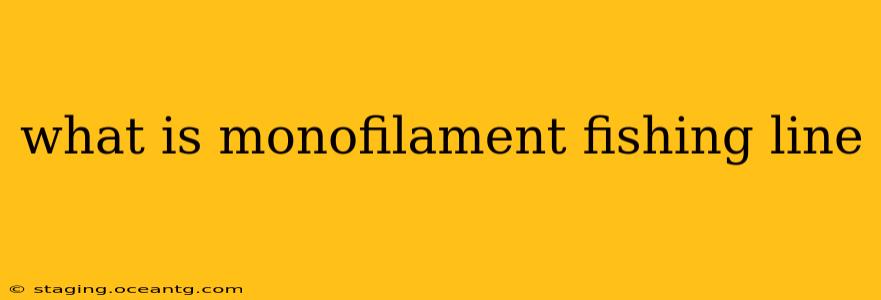Monofilament fishing line is a type of fishing line made from a single, continuous filament of synthetic material, typically nylon. It's the most common type of fishing line used by anglers worldwide due to its versatility, affordability, and relative ease of use. Understanding its properties is key to choosing the right line for your fishing needs.
What are the characteristics of monofilament fishing line?
Monofilament line boasts several key characteristics that make it a popular choice:
- Flexibility: It's relatively flexible and easy to cast, making it suitable for a wide range of fishing techniques.
- Strength: While not as strong as some other types of line (like braided line), monofilament offers good strength-to-diameter ratio, meaning you can get a thinner line with decent strength.
- Stretch: This is both a benefit and a drawback. The stretch absorbs shock during the fight with a fish, protecting your rod and line from breaking. However, too much stretch can make detecting subtle bites more difficult.
- Transparency (to some degree): Monofilament line is generally less visible underwater than braided line, making it a good option for shy fish. However, the visibility depends heavily on the water clarity and the line's color.
- Affordability: Generally, monofilament is the most budget-friendly option.
What are the different types of monofilament fishing line?
While all monofilament is made of a single filament, variations exist in material composition and manufacturing processes, resulting in lines with slightly different characteristics. These variations impact factors like strength, abrasion resistance, and knot strength. Some manufacturers offer specialized monofilaments for specific applications, such as:
- High-Visibility Lines: These are often bright colors (yellow, orange, etc.) for easier tracking in low-light conditions or murky water.
- Low-Stretch Lines: Designed to minimize stretch, offering better sensitivity and hook-setting power.
- Abrasion-Resistant Lines: Built to withstand the rigors of fishing in rocky areas or around heavy vegetation.
What are the advantages of using monofilament fishing line?
- Cost-effective: It's generally less expensive than other types of fishing line.
- Versatile: Suitable for various fishing techniques and species.
- Easy to handle and tie knots: Less complex to work with than braided or fluorocarbon lines.
- Good knot strength: Provides reliable knot strength when properly tied.
- Good shock absorption: The stretch minimizes the risk of line breakage during fights with large fish.
What are the disadvantages of using monofilament fishing line?
- Memory: It can sometimes develop memory, causing it to coil up and hinder casting.
- Visibility: While generally less visible than braided line, it can still be visible in clear water.
- Abrasion susceptibility: Less abrasion-resistant than some other line types.
- Stretch: While useful in some scenarios, the stretch can also make it difficult to detect light bites.
- UV degradation: Exposure to sunlight can weaken the line over time.
What is the difference between monofilament and fluorocarbon fishing line?
Fluorocarbon line is also a single filament, but it’s made from a fluorocarbon polymer. This gives it several advantages over monofilament:
- Higher refractive index: Fluorocarbon is almost invisible underwater.
- Higher density: Sinks faster than monofilament.
- Greater abrasion resistance: More resistant to cuts and abrasions.
- Less stretch: Provides better sensitivity and hook-setting power.
However, fluorocarbon is generally more expensive than monofilament.
How do I choose the right monofilament fishing line?
Selecting the right monofilament line depends on several factors:
- Target species: Larger, stronger fish require a heavier-test line.
- Fishing technique: Certain techniques require specific line properties (e.g., low stretch for finesse fishing).
- Water conditions: Murky water might benefit from high-visibility line.
- Budget: Monofilament offers a range of price points to suit various budgets.
By understanding the characteristics and considerations discussed above, you can choose the best monofilament fishing line for your specific fishing needs and enjoy a more successful angling experience.
